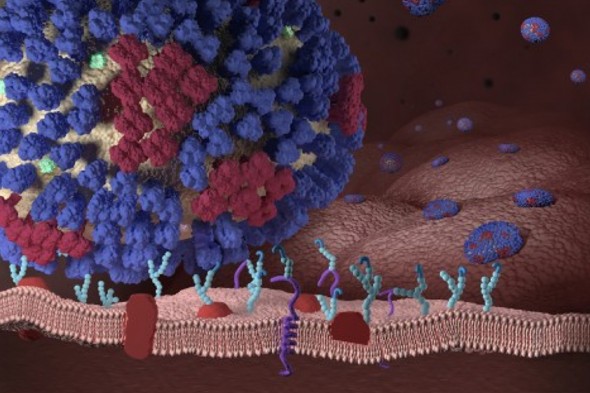Common food additive may block deadly avian flu

Illustration shows an influenza virus making contact in the beginning stages of an influenza infection. Image: Centers for Disease Control and Prevention
A common food additive can block a deadly new strain of avian influenza virus from infecting healthy cells, College of Medicine researchers found.
The compound, widely used as a preservative, binds to a part of the flu virus that has never been targeted by any existing antiviral drug, raising hopes for its effectiveness against multi-drug-resistant flu viruses.
“The recent H7N9 outbreak in China this past March had a mortality rate of more than 20 percent,” said Michael Caffrey, associate professor of biochemistry and molecular genetics.
That strain, which is new, is already showing resistance to most drugs used to treat it, Caffrey said.
Preventing an outbreak that could lead to mass casualties would be difficult with the current arsenal, he said.
“The need to develop new antiviral therapeutics now is crucial.”
Flu viruses enter host cells using a special protein called hemagglutinin, which acts as a “key” that opens receptors on the cell surface. If hemagglutinin is disabled, the virus is locked out and can’t infect cells.
UIC researchers, led by Caffrey, found that the FDA-approved food additive tert-Butylhydroquinone — known as TBHQ, commonly used in fast foods, pet foods and cosmetics — sticks to a specific region on the hemagglutinin molecule.
The additive, he said, “attaches to the Achilles’ heel of the virus’ loop-shaped portion of hemagglutinin necessary for binding to cells, making cell infection impossible.”
The loop on the hemagglutinin molecule represents a new therapeutic target, since existing drugs don’t go after it, Caffrey said.
“Any drugs that focus on the hemagglutinin loop would be totally novel to flu viruses, and so resistance, if developed, would still be a long way off.”
The researchers are looking for ways to enhance tert-Butylhydroquinone’s ability to prevent infection.
One way might be to add it to poultry feed — keeping the virus from spreading in chickens could reduce the likelihood of it jumping to humans, Caffrey said.
While the compound is used in a variety of foods as a preservative and stabilizer, questions remain regarding its safety if consumed in very high doses.
The findings were published in the online journal PLOS ONE. Coauthors are graduate student Aleksandar Antanasijevic, postdoctoral researcher Han Cheng, Duncan Wardrop, associate professor of chemistry, and Lijun Rong, associate professor of microbiology and immunology.
sparmet@uic.edu
